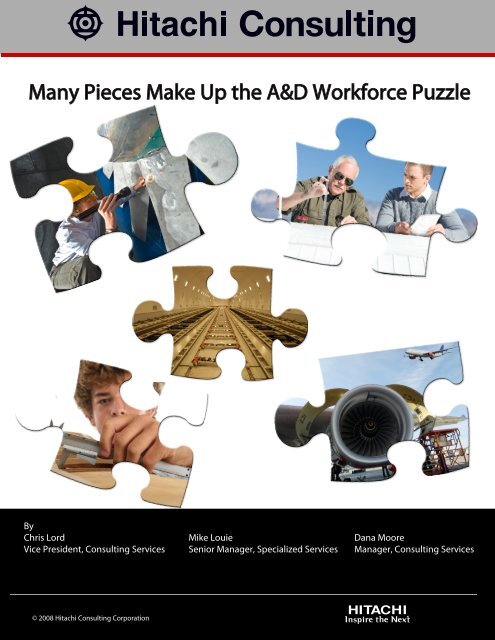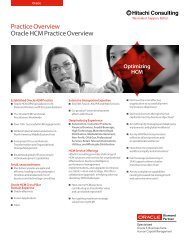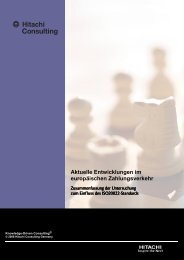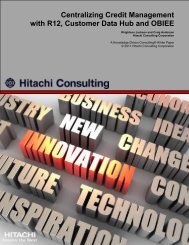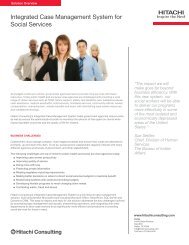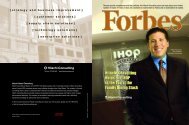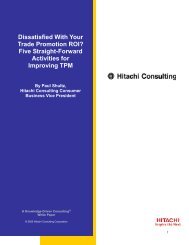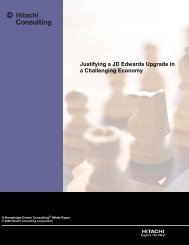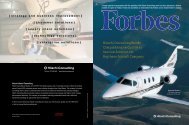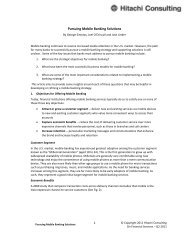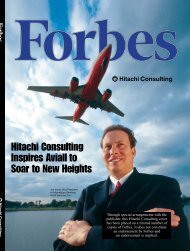Many Pieces Make Up the A&D Workforce Puzzle - Hitachi Consulting
Many Pieces Make Up the A&D Workforce Puzzle - Hitachi Consulting
Many Pieces Make Up the A&D Workforce Puzzle - Hitachi Consulting
Create successful ePaper yourself
Turn your PDF publications into a flip-book with our unique Google optimized e-Paper software.
<strong>Many</strong> <strong>Pieces</strong> <strong>Make</strong> <strong>Up</strong> <strong>the</strong> A&D <strong>Workforce</strong> <strong>Puzzle</strong>ByChris LordVice President, <strong>Consulting</strong> Services?Mike LouieSenior Manager, Specialized ServicesDana MooreManager, <strong>Consulting</strong> Services© 2008 <strong>Hitachi</strong> <strong>Consulting</strong> Corporation1
Aerospace and Defense (A&D) companies are trying to stem <strong>the</strong> tide of <strong>the</strong>numbers of employees with many years of experience, specialized skills,industry knowledge, and company know-by this industry as a potential companies are facingsignificant changes to <strong>the</strong>ir workforce as large numbers of employees reach <strong>the</strong>Why A&D is DifferentAccording to AerospaceIndustries Association (AIA)statistics, almost 60 percentof <strong>the</strong> U.S. aerospaceworkforce was age 45 orolder in 2007.s wreaking a differenthorizon (according to Aerospace Industries Association (AIA) statistics, almost60 percent of <strong>the</strong> U.S. aerospace workforce was age 45 or older in 2007)about filling those jobs with <strong>the</strong> right mix of advanced talent and skills to takeand talented resources to pull from. As underscored by <strong>the</strong> data in Figure 1 from<strong>the</strong> recent Aberdeen Group report Insight on Aerospace and Defense <strong>Workforce</strong>Planning Programs, A&D companies are feeling <strong>the</strong> pressures around <strong>the</strong>changing workforce more than o<strong>the</strong>r industries in all of <strong>the</strong> top four measures.The A&D industry is distinctive because of <strong>the</strong> specialized knowledge andtraining it takes to fill <strong>the</strong> job roles in companies handling space and defenseprojects. According to A&D employers, industry analysts and related industryengineering, and math (STEM) backgrounds to fill <strong>the</strong> future openings. In fact,<strong>the</strong>re has been a lot of press recently around aerospace, aeronautic associationsand A&D companies discussing <strong>the</strong> need to get more students interested in A&Dcareers despite years of effort already invested in STEM-focused attempts. Foryears, companies like Lockheed Martin, Boeing, Texas Instruments, NorthropGrumman, and o<strong>the</strong>rs have been working with students as young as elementaryquite had <strong>the</strong> desired effect.During a forum last spring focused on A&D workforce concerns, sponsoredjointly by AIA and <strong>the</strong> American Institute of Aeronautics and Astronautics (AIAA),it was pointed out that despite significant investments in both time and money inSTEM programs over several years, <strong>the</strong>re has been no measurable gain in <strong>the</strong>number of students entering those fields. A renewed call for improved STEMaction is still needed for teachers, students and programs to spark interest inaerospace and related careers. In a story in <strong>the</strong> AIA <strong>Up</strong>date, Marion Blakey, AIApresident and CEO, told attendees that <strong>the</strong> issue was bigger than any oneresources and public relations has a role in identifying solutions to <strong>the</strong> workforce
The Generation Gapwithout <strong>the</strong> glamour and excitd space-related. In those days,<strong>the</strong>se things fueled <strong>the</strong> fire for engineers and o<strong>the</strong>rs looking for an exhilaratingcareer to latch onto.Companies must initiateprograms to widen <strong>the</strong> neckof <strong>the</strong> funnel to increase <strong>the</strong>number of qualifiedgraduates in <strong>the</strong> pool ofAerospace and Defensecandidates.ounger Gen Xers and Gen Yers preferGoogle and Microsoft to Northrop Grumman and Lockheed Martin. Admittedlyn ugly word.The idea of producing weapons of war and <strong>the</strong>ir related systems are turningunattractive to be in A&D.Bridging <strong>the</strong> GapTo help overcome <strong>the</strong>se issues, A&D companies must help <strong>the</strong> industry be moreappealing; to be able to compete with high-paying computer science jobs thatgive employees cool gadgets and benefits, and find ways to develop leadershipopportunities and provide career acceleration that appeal to Gen Y employees.They must also continue involvement in STEM-related programs, sponsorships,and investments.Invest in research and development (R&D) projects to get undergraduatesinvolved and interested in <strong>the</strong> industryJunior AchievementInvest in a corporate sponsorship of tech centers and fairs, andlab environmentsof <strong>the</strong> world who allow employees to spend 20 percent of <strong>the</strong>ir work time onfree project incubationAllow for self-initiated research and development, and provide forums forengineers to bring <strong>the</strong>ir project ideas to managementUse advertising that focuses on space and exploration, commercial aircraft,HighSchoolCollegeStudentsEntering HighSchoolSTEMProgramsCoreEngineeringChoosingAerospace &Defense as aCareerQualifiedEngineeringGraduatesCompanies must initiate programs to widen <strong>the</strong> neck of <strong>the</strong> funnel to increase <strong>the</strong>number of qualified graduates in <strong>the</strong> pool of Aerospace and Defense candidates
To do this more effectively, <strong>the</strong>re must be a deeper visibility into workforceassets. A&D firms need robust knowledge management and resource planningtools that include granularity of capabilities, competency and experience, and aninventYour company should place an emphasis on required knowledge-sharing.Create a culture that supports knowledge transfer, leveraging past experiences,versioning and sharing in an industry that historically benefits people for hordingcapability using both internal and external resources to help spread knowledgeand how-toringprograms to build relationships and a network that facilitates <strong>the</strong> spread andsharing of knowledge. These relationships can evolve into a barrier to exit asyounger employees build stronger relationships within <strong>the</strong> firm.The Offshore SolutionOftentimes companies look offshore to help fill employment ranks when <strong>the</strong> needarises. However, this is less of an option for American defense and space firmswith strict security rules, regulations and government contracts. Securityclearances are required for a majority of work done at A&D companies andforeign workers usually are not eligible for high-level security clearances.for employees. While many overseas colleges and universities are graduatingin civil, mechanical and aerospace engineering because <strong>the</strong> same market forcesthat make those careers less attractive in <strong>the</strong> United States are also at workoverseas.Robust systems forknowledge management,career performancemanagement, skills-basedsuccession planning, andskills development are alltools to help manage <strong>the</strong>organic growth of experts.some creative planning to achieve. Taking a cue from highly classified,compartmentalized projects, break programs into classified and unclassifiedpieces allowing highly valuable, security cleared employees to focus on <strong>the</strong>classified pieces instead of diluting <strong>the</strong>m with unclassified work. In some cases,<strong>the</strong> unclassified pieces can be compartmentalized and taken offshore. Alsoextend STEM investments into relationships and programs with universities andinstitutions overseas.To drive down this path, a company needs processes that combine visibility intoclearance management and human capital management, <strong>the</strong> planning capabilityto efficiently break programs into classified and non-classified chunks andmanage <strong>the</strong>m in one stream, and multi-level security controls for collaboration,design, development, and data management solutions.Unportability of EngineersEngineers are just not portable between industries, companies, or evenprograms within a company. Their skills are highly specialized. For example,resources can go underutilized if <strong>the</strong> supply of skilled labor and <strong>the</strong> demand fromprograms are not planned and analyzed at a granular enough level.This is <strong>the</strong> main function of a mature workforce planning function. Companiesneed to forecast <strong>the</strong> requirements for those skill sets and develop a plan toconsolidate skills into <strong>the</strong> minimum number of distinct sets. With that in hand, acompany can engage mentoring, job rotation, and apprenticeship programs togrow those skills organically. Consider removing extraneous work from <strong>the</strong> mostsenior and knowledgeable individuals to allow <strong>the</strong>m to build <strong>the</strong> next generationof experts.Robust systems for knowledge management, career performance management,skills-based succession planning, and skills development are all tools to helpmanage <strong>the</strong> organic growth of experts.
The good news, as evidenced in Figure 4 by <strong>the</strong> data from A&D respondents to<strong>the</strong> Insight on Aerospace and Defense <strong>Workforce</strong> Planning Programs survey, isthat <strong>the</strong>re is hope. Companies that know how to address <strong>the</strong>se issues areshowing direct and significant business improvement from <strong>the</strong> implementation of<strong>the</strong>se programs, processes, and systems.ConclusionThe loss of knowledge, skills, and experience from <strong>the</strong> current A&D workforcedue to retirement and <strong>the</strong> reduction in <strong>the</strong> number of engineers entering <strong>the</strong>industry has created significant pressures on aerospace and defense companiesas <strong>the</strong>y try to maintain critical expertise.Companies are working hard to mitigate <strong>the</strong> effects of retirement through alumninetworks, updates to <strong>the</strong>ir HR policies to access retirees as part-timers,contractors, or project-specific staff, and utilizing information technology to trackpast workers as potential rehires.At <strong>the</strong> same time, immediate actions are available to try and organically growexpertise and experience within <strong>the</strong> firm. Mentoring, job rotation, andapprenticeship programs are all candidates for skills and experience uplift.Systems, processes, and policies for knowledge management, careerperformance management, skills-based succession planning, and long-range,granular, program planning for skills needs, are all poised to provide <strong>the</strong>information necessary to take significant action.Longer-term investments in STEM educational programs such asundergraduate research and development projects, Teacher for a Day, JuniorAchievement, corporate sponsorship of events such as science fairs -- andcreation of creative opportunities coupled with increasingly sophisticatedmethods for tracking, measuring and assessing <strong>the</strong> impact of <strong>the</strong>se investmentsare all working to increase <strong>the</strong> number of students entering core engineeringprograms and, subsequently, choosing A&D as a career.###onsolutions, contact Chris Lord at clord@hitachiconsulting.com (1.714.743.4355);Mike Louie at mlouie@hitachiconsulting.com (1.714.883.1398), orDana Moore at dlmoore@hitachiconsulting.com (1.714.585.3908).


